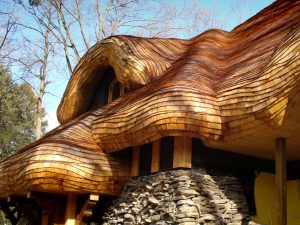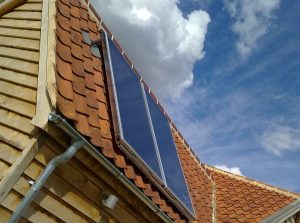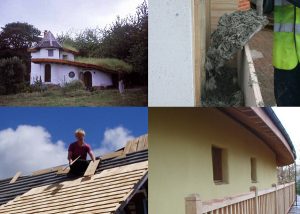Roofing - introduction

“The time to repair the roof is when the sun is shining” – John F Kennedy
Contents
What is roofing?
Building a roof is the most primal building activity of all. A roof alone is already a building, but a building without a roof is barely one at all. Roofs are so ubiquitous in fact that it can seem like a statement of the obvious to discuss them; Encyclopedia Britannica is a great place to get the basics of roofing. Roofs come in an enormous variety of forms, and of course once upon a time they were all DIY. The world is full of materials with which we might cover our heads, and if we pay attention to the world around us, as much as our ancestors clearly did, it is also replete with examples of how we might use those materials to make roofs.
The crucial thing about a roof is its span. Without a span a roof is no more than a big coat, something floppy we can crawl under for shelter, but not something which provides any more space than we can make with a raised arm. So the materials to hand, and the skills available dictate what kind of span you can create; your climate will soon provide feedback on the success of your venture.

Caves are dangerous places, in the distant past often inhabited by large and toothsome creatures. It wouldn’t be at all surprising if roofs actually pre-dated caves as human shelters. A lean-to roof of ferns or leafy boughs against a fallen tree, or two long branches draped with a skin make a roof. The earliest roofs evolved from no more than the realisation that something resting on something else made a space underneath more comfortable than sitting in the rain.
The materials from which the first roofs were made are still current in the world of roof-building. Timber frames, bark, thatch, the fabric roofs of structures like yurts, all recall the first roofs. Since then though new materials have become available: the vaults of stone and masonry roofs, steel roofs, and concrete roofs.

The simplest roof spans are single-pitched or lean-to roofs, then there are pitched roofs with two sides, and hipped roofs with four or more pitches coming together at hips, either external or internal; there are gambrel or so-called pepper pot roofs, and hipped gambrels; there are domes and arched roofs, and there are combination roofs. Roofs come in all shapes and sizes, responding to the imperatives of economy, climate and culture; rarely, even in a street of apparently identical houses are any two roofs entirely alike.
As in so many areas of ecological building, the choices for construction then, divide clearly into two groups: the roofs which draw on ancient traditions and materials, and those which use modern, high-embodied energy materials and styles. Green roofs arguably represent a fusion of ancient turf and timber roofs with the membrane materials available to modern builders.

What are the benefits of roofing?
Whilst the benefits of a good roof perhaps do not need to be restated, from a design perspective it is always worth looking again at function. All projects start with design even if no structured process takes place, and so when coming to put a roof on something it is worth asking why one kind of roof has been chosen over another.
For earth and straw bale buildings a roof needs to protect the walls, a “good hat” they used to say. For any building a roof is a hat: it keeps the building warm when the weather is cold and should keep it cool when the weather is hot; the roof should keep the rain and the snow out, protecting both the occupants and the structure beneath. If ever you’ve been in a house with a draughty roof, you’ll know that a roof that keeps the wind at bay is also a nice feature for a building. Roofs can sound-proof, and they can regulate moisture, dealing with all the water vapour caused by the people living underneath; they can also be designed with the simple idea of providing more living space than do the walls alone.
So far, so apparently obvious, but it is extraordinary how many roofs seem to have been built without the full potential of the structure in mind. We’ve probably all been in lofts with roof trusses that would make conversion of the space for living in next to impossible, or at the very least hugely expensive. This is just one example of common poor design.
Roofs can do more still. A roof can be the place where you generate your power, and if it is going to do that you’ll need to think about how and where to put your solar panels, and the aspect and slope of your roof, as well as the position and latitude of your dwelling. The same is true if you want the roof to be the place where you make some or all of your hot water. The roof can be where you harvest your rainwater, and so you’ll need to think about what kind of roofing materials are best for that, how clean your roof will be, and how your roof design and gutters will work with your water tanks, ponds, and the wider landscape. When we design roofs properly we’re almost certainly not going to be able to build the ideal roof, something will stop us: money, location, planning or building regulations, but thinking about that ideal roof might get us closer to the solutions we would like to see in place.

Roofs can also be conceived of as both wildlife habitats – build your roof for the bats, for the birds and you’ll reap the rewards in your organic veg garden down below – and as productive spaces in their own right. Roofs might be good sites for urban and suburban apiaries, they might also provide a good place to grow those dry-loving herbs that won’t grow anywhere else; a roof is usually – not always – higher than the property it sits on, and so is above sinking cold air: it’s not such a bad environment for season extension and early cropping.
Roofs can do all these things and they can also be a fantastic canvas for art: your roof can be a bold statement as anyone who ever saw the Headington Shark roof on the edge of Oxford will testify.

Ecological buildings have long been known for their naturalistic and beautiful roofs, but long before people thought in terms of ecological housing or otherwise, thatchers decorated their work, and roofers of all kinds had distinctive marks that advertised their trade through art.
Here is information on the environmental impact of various roofing materials, in terms of embodied energy and toxicity (wooden shingles came out best, followed by natural slate, as long as it’s from your country).
What can I do?
The easiest step of all, oddly perhaps, is to put a roof on something. Start with a dog kennel or a shed. Build a light framed wooden roof, board it and cover it with roofing felt. A shed roof, or a lean-to shelter for firewood, can be the start of a DIY roofer’s apprenticeship. Farmers around the world learn their roofing by building animal shelters. The crucial thing to remember is that not long ago everyone on Earth built their own roofs. Roofing small structures teaches the basic skills and physics involved whilst also providing the opportunity to get creative, use recycled materials, collect a few tools together, and have a go at guttering and rainwater harvesting as well.

You can attend general roofing courses, or courses for specific types or aspects of roofing – see ‘related topics’ (right); but if you’re serious about roofing, if you feel drawn to the trade, then work for a roofer. There used to be a story going around of a nomadic worker’s co-op of anarchist roofers, if it was never true then it should have been. The world is full of roofs that need work, and you don’t need to have the skills or courage of a steeplejack to learn enough to be useful.
Working on a roof can become an obsession, it can become difficult to pass a roof without staring at it, and it can become dangerous to drive anywhere because of the constant temptation to look up at roofs – but one of the things that you can do is exactly to become passionate about roofs, stare at them and study them.
On one level roofing is very accessible – roofs are all around us, and we can all find the time and resources to build a little shed. On another level though, roofing is quite out of reach for most. Roofing is dangerous and roofers use scaffolding and safety barriers even when they are not at all far off the ground; roofers’ tools are highly specialised and expensive. You might find yourself in a situation where your next question to yourself should be “could I kill myself if I try to do this?” If that’s the question in your mind, then stop. Call a professional roofer. If you can’t afford one, befriend a roofer; buy a builder’s sheet and cover the hole up until you can afford one. Do not do the silly thing that you know you shouldn’t do.
Roofing can be learned, and like all building jobs can be made safe with proper precautions. Some roofing jobs will require more than one pair of hands, but the vast majority of roofing jobs can be done with a sensible DIY approach and an appropriate amount of thought beforehand.

Roofing is weather dependent, and it is vital that you’re prepared to cover up the structure you’re roofing if the weather changes. You don’t want the straw bale walls or the cob to get wet, and if the roof is on a building that’s already inhabited you don’t want your well-intentioned roof repair to turn into a catastrophe for carpets and ceilings down below.
Specialist(s)
Thanks to Paul Jennings of Lowimpact.org for information.

Bez Walker helps the family-owned roofing specialists, Ashbrook Roofing Supplies, source natural and low-impact roofing materials for clients from across the building spectrum. Our desire is to share knowledge and give people choice in the products that they purchase – whether it be locally sourced, reclaimed or lower-impact products alongside more traditional and modern roofing materials.










2 Comments
That’s awesome and good one. Roofing can be done all premises. We would like to infuse solar roofing methods in our upcoming projects.
One can learn roofing but they should learn and get trained well. Then they can go for installation.
That’s awesome and good one. Roofing can be done all premises. We would like to infuse solar roofing methods in our upcoming projects.
One can learn roofing but they should learn and get trained well. Then they can go for installation.